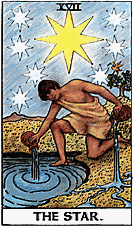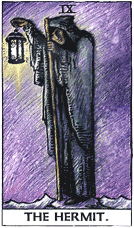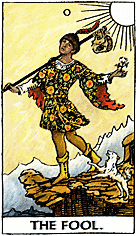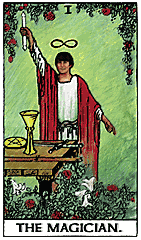By Kevin Hendryx
There is something magical and sinister about repetitive siblings. Mythology is very strong on them. The Beatles inspire terror, awe, and reverence.
—Jonathan Miller
Linked indissolubly with the 1960s, split for thirty years, John Lennon dead twenty years—and still the Beatles remain timeless. Everything the Former Fabs do is faithfully followed by admirers, enemies, and the press alike, and their legacy as musicians, composers, and, yes, philosophers survives and is channeled by the many who have been transformed by their spirit. We need look no further than Berlin 1989, when their songs played as the Wall came down—a more bizarre parallel to the Rescue of Pepperland could not be scripted—to see that truly "nothing is Beatleproof."
John Lennon sang, "I don't believe in Tarot" (among other things) in his song "God" in 1970, shortly after the breakup of the Beatles. As with many of Lennon's pronouncements, he may have meant it at the time, during his embittered "primal scream" phase, but would not necessarily continue to believe so. By the end of John's life, he and Yoko Ono were again earnestly consulting the I Ching and having their fortunes told (and their pockets picked by charlatans) like the unrepentant flower children they were. The Beatles are still seen as the totemic icons of the 1960s, emissaries from the Age of Aquarius, whose coming coincided with a reawakened interest in the occult and mysticism. One of the many practices that suddenly gained new adherents was that of reading clues to one's personality and destiny from cards randomly selected from the Tarot deck.
The Tarot, the ancient precursor of today's playing cards, deals in archetypes and symbolism, especially in the twenty-two trump cards of the major arcana ("greater secrets"). All four Beatles, in varying degrees of enthusiasm or gullibility, became absorbed in the spiritual questing that marked the unfolding of the 1960s, and it is thus all the more fascinating to note how uncannily each member of the group, even the band as a unit, is mirrored by a particular major arcana card. As the Beatles recede as historical figures and enter the realm of myth and legend, it is appropriate to examine how they fit into the allegorical context of the Tarot.
Take what follows as an excursion into the collective unconscious or an exercise in voodoo musicology, whichever you like. As Pindar wrote, "In heaven, to learn is to see; on earth, to remember." Let us now try to remember a time when mortal minstrels dared conjure visions of heaven.
Ringo's card: The Star
 The card chosen for Richard Starkey (Ringo Starr) is number 17 in the sequence of the major arcana: the Star. More than just a serendipitous pun, this card represents hope, trust, and optimism. Its positive aspects include bright prospects, opportunity, and satisfaction. Anchored in the sky and cosmos, it is the first card to complement and complete the gifts of the Magician (see below). Seven smaller stars are depicted in the card's illustration, one for each note in the music of the spheres, while a young girl under a single radiant star pours the purifying water of life into the consciousness of humanity. The Star is one of the happiest cards, acting as a check on the influences of ill-omened cards around it.
The card chosen for Richard Starkey (Ringo Starr) is number 17 in the sequence of the major arcana: the Star. More than just a serendipitous pun, this card represents hope, trust, and optimism. Its positive aspects include bright prospects, opportunity, and satisfaction. Anchored in the sky and cosmos, it is the first card to complement and complete the gifts of the Magician (see below). Seven smaller stars are depicted in the card's illustration, one for each note in the music of the spheres, while a young girl under a single radiant star pours the purifying water of life into the consciousness of humanity. The Star is one of the happiest cards, acting as a check on the influences of ill-omened cards around it.
The inversion, or reversal, of the Star card brings negative effects into play. These include bad luck, pessimism, disappointment, imbalance, lack of opportunity, and hope unfulfilled.
Interpretation: Ringo brought good-natured cheer and down-to-earth sensibilities to the Beatles. He was the only one of the four who came from a truly poor, working-class environment and never strayed far from his roots. At the same time, he proved capable of intuitive reasoning, astute insights, and droll malapropisms that frequently amazed and delighted his bandmates. Ringo harbored the fewest resentments and made the fewest enemies. An only child, even after the split he continued to refer to the others as "my three brothers." He provided a center for the others to rally around, musically and spiritually, and as the drummer he was especially important to John, the shaman. In public or private moments captured on film, John often stayed close to Ringo and looked to him for support or reassurance. The feeling was mutual, as Ringo later recalled: "He [John] knows me better than anybody else in the world--better than the other two." Ringo typified the ability of common persons to rise above their origins and achieve greatness. The reversed meanings of the Star, on the other hand, aptly sum up the failings of Ringo's solo career, as Beatle scholars will recognize.
Archetypal Song: "With a Little Help from My Friends," written specifically for Ringo by John and Paul, cemented his public persona as "history's most charming bit player." It features his best Beatles vocal and firmly projects all the exuberance and faith of his Tarot card.
George's card: The Hermit
 Next we turn over a card for George Harrison: the Hermit, the ninth card, representing both a seeker and teacher. Positive attributes of the Hermit include knowledge, deliberation, thriftiness, caution, silent counsel, and inner wisdom. The Hermit wears the hood and scourge of a penitent and carries the walking stick of a pilgrim. He stands on a summit and holds the lantern of truth, illuminating the path to heaven. Through his searching, the way is revealed to others. Selfless but also somewhat distant, the Hermit realizes that few are ready for the truth; his light can also blind, and secret knowledge must be hidden. Socrates' dictum "I know that I know nothing" could be the mantra of this reclusive card.
Next we turn over a card for George Harrison: the Hermit, the ninth card, representing both a seeker and teacher. Positive attributes of the Hermit include knowledge, deliberation, thriftiness, caution, silent counsel, and inner wisdom. The Hermit wears the hood and scourge of a penitent and carries the walking stick of a pilgrim. He stands on a summit and holds the lantern of truth, illuminating the path to heaven. Through his searching, the way is revealed to others. Selfless but also somewhat distant, the Hermit realizes that few are ready for the truth; his light can also blind, and secret knowledge must be hidden. Socrates' dictum "I know that I know nothing" could be the mantra of this reclusive card.
Negative aspects of the Hermit revolve around imprudence. A Hermit who loses his way in the dark shows hastiness, immaturity, and a lack of patience. He withdraws from his responsibilities toward others. He becomes a follower rather than a leader, and attainment yields to hollow pursuits.
Interpretation: George contributed a spiritual imperative to the Beatles' music, assuming a teacher's role in a group in which he was the junior member in age. He was the first to consider the potential of a life and purpose beyond material rewards and Western consumerism. Originally typecast as the almost invisible lead guitarist with a miserly streak, the "quiet Beatle" metamorphosed into a leading spokesman for Indian music and philosophy. As the Hermit, he is generally able to look back at the road his life has followed with tolerance and understanding, even a trace of amusement; but his eyes are fixed on a goal that still lies ahead.
Archetypal Song: "Within You without You" is George's most fully realized blending of classical Indian raga and Western pop idioms. "World music" is now so taken for granted that few remember, in the hot glare of the Beatles' joint fame, to credit George as being one of its earliest pioneers. Quoting in equal parts from the Bible and Hindu scriptures, this song reveals profound insights but ends in the sardonic laughter of those who listen but do not hear. It is a joke the Hermit is all too familiar with: "Of what use are words of wisdom to the man who is unwise? Of what use is a lamp to a man who is blind?" (Dhammapada).
Paul's card: The Fool
 Our third Beatle, Paul McCartney, is represented by the Fool, a card denoting pure creativity, enthusiasm, theatricality, unpredictability, and inexperience seeking self-expression. The only unnumbered card in the Tarot deck, the Fool stands apart from the normal sequence, unconfined by boundaries. In part, this difference is supremely liberating; however, having a value of zero means the Fool counts for nothing by himself. He requires the addition of other cards, which are then modified by his influence. The Fool typically wears a gaudy disguise--his appearance is designed to deceive--thus he also represents concealed wisdom (as in "The Fool on the Hill").
Our third Beatle, Paul McCartney, is represented by the Fool, a card denoting pure creativity, enthusiasm, theatricality, unpredictability, and inexperience seeking self-expression. The only unnumbered card in the Tarot deck, the Fool stands apart from the normal sequence, unconfined by boundaries. In part, this difference is supremely liberating; however, having a value of zero means the Fool counts for nothing by himself. He requires the addition of other cards, which are then modified by his influence. The Fool typically wears a gaudy disguise--his appearance is designed to deceive--thus he also represents concealed wisdom (as in "The Fool on the Hill").
There is an instinctive affinity with the Magician card (see below)--the sorcerer's apprentice and all that. The two are linked paths to the same sephira on the Tree of Life in the Hebrew Kabbalah, and their union produces original inspiration that is unmatched in the Tarot.
All is not bliss for the Fool. A reversed card indicates folly. Bad decisions are likely, as is negligence, frivolity, rashness, indiscipline, a tendency to show off, unrestrained excess, thoughtlessness, and a halting in life's progress. As the Dhammapada says: "How long is the night to the watchman; how long is the road to the weary; how long is the wandering of lives ending in death for the fool who cannot find the path!"
Interpretation: Paul needed the Beatles more than the others did. He thrived in the identity and framework provided by the group and flourished in the public acclaim of the concert stage. The Fool's creativity made Paul the most natural musician, albeit wholly untrained, in the band. His innate Celtic romanticism revealed itself in a love of story-telling songs (as opposed to sharing personal experiences) and in a love of sounds for their own sake. More than the others, he writes from the heart, not the mind, and his imagery is more frequently drawn from nature. He is pastoral and reflective whereas George could be acerbic and admonitory, or John would take refuge in the surreal and grotesque. In his songs, Beatles music best expresses the pure joy of living.
There is another level of meaning, too. The Fool may be a comedian, but comedians are often the loneliest of people, seeing a joke that no one else can share. The remorseless opposite mask to comedy is tragedy. Paul's life has been full of rewards and achievement, but the early death of his mother, the murder of his old writing partner, and the sad loss of his lifemate Linda were inconsolable blows.
Archetypal Song. "Penny Lane" shows the enthusiasm Paul gave to the group paired with his keen ear for songcrafting. Expansive whereas Lennon's comparable "Good Morning, Good Morning" is repressed and edgy, this nostalgic fairytale conjures up a fantastical Liverpool where even the everyday routines of ordinary people promise magic and delight. Baroque trumpets, piano glissandos, and ascending melodies whirl the listener out of mundane concerns; some experience akin to this must have been what caused Jung to write foretellingly, "Liverpool is the center of the Universe." Paul has never lost this knack for self-referential whimsy; a recent song such as "Flaming Pie" reminds us that, in nursery rhyme lore, it is "Simple" Simon, the Fool, who also encounters a "pieman."
John's card: The Magician
 The Magician is the first card in the major arcana, so it is fittingly assigned to John Lennon, the founder and titular leader of the group. The Magician (also called the Sorcerer, the Juggler, or the Minstrel) is the card of human consciousness seeking to manifest its latent divinity. It is identified with the power to bring things into being, and with originality, dexterity, spontaneity, self-reliance, resolution, imagination, and transformation. The Magician is portrayed with his arms reaching to both sky and earth ("my Mother was of the Sky / my Father was of the Earth." a curious inversion of the standard mythic references, but one perhaps more personally meaningful), suggesting the Hermetic adage "as above, so below" and emphasizing the essential unity of all things ("but I am of the Universe").
The Magician is the first card in the major arcana, so it is fittingly assigned to John Lennon, the founder and titular leader of the group. The Magician (also called the Sorcerer, the Juggler, or the Minstrel) is the card of human consciousness seeking to manifest its latent divinity. It is identified with the power to bring things into being, and with originality, dexterity, spontaneity, self-reliance, resolution, imagination, and transformation. The Magician is portrayed with his arms reaching to both sky and earth ("my Mother was of the Sky / my Father was of the Earth." a curious inversion of the standard mythic references, but one perhaps more personally meaningful), suggesting the Hermetic adage "as above, so below" and emphasizing the essential unity of all things ("but I am of the Universe").
The four symbols of the lesser arcana (cups, pentacles, batons, and swords) are displayed, an allusion to the four elements and the four letters of the unpronounceable name of God, the Tetragrammaton.
Just as creativity and power can be misused, there are less favorable aspects to the Magician. Typically, they are weakness of will, insecurity, delay, lack of interest, intrigue, deceit, and skills applied to destructive ends.
Interpretation: John was the wizard of the Beatles, the voyager to the otherworld who returned with visions and the power to energize those around him. He brought a restless creativity to the band and an Irish love of language and wordplay. Like many minstrels, he often sang in riddles, lest sacred mysteries be revealed to the unready or profane. The "fire in the head" of the ancient bards (as William Butler Yeats called it) was his special gift and burden. Because he was never long content with the way things were, he never ceased to challenge us to be better than we are. John sang of imagining possibilities. "Reality," he once said, "leaves a lot to the imagination." Without his initial dream, the Beatles would have never existed.
Archetypal Song. "Tomorrow Never Knows" is his most mind-bending and discorporeal song. The lyrics were borrowed freely from sacred texts such as the Tibetan Book of the Dead (Bardo Thodol), a collection of instructions to help departed souls navigate the afterlife state and escape the cycle of death and rebirth ("Go far into the Void and there rest in quietness" from the Tao Te Ching). John chants of ego dissolution and joining with the Infinite, wafting through a disorienting maelstrom of soundscapes, yet always anchored by Ringo's trance-inducing drum patterns. It was for precisely this reason that tribal shamans formed close attachments to their percussionists.
The evolution of the Beatles, and John in particular, was nothing short of astonishing, as this song, recorded just four years after their first single, makes clear. It was a long way from "Love, love me do / You know I love you" to "Turn off your mind, relax, and float downstream / It is not dying; it is not dying."
The Beatles' card, all together: The World
The World is the twenty-first and final card in the major arcana and the culmination of all the others. The World signifies attainment, completion, success, triumph in undertakings, rewards of hard work, admiration of others, an aerial voyage, and apotheosis. The card shows a young woman encircled in a wreath forming a mandorla, or vesica piscis--nature surrounded by the divine, the worlds of spirit and matter meeting. She has a leg raised in a dance, evoking Shiva Nataraja's dance of creation, and she holds a wand in each hand to illustrate the opposing principles of duality (yin/yang, light/dark, male/female). In the corners of the card are the tetramorphs, the four allegorical evangelist figures from Ezekiel's vision and the Revelation of Saint John: a bull, a lion, an eagle, and an angel.
In its imperfect form, the meaning of this card is, simply, imperfection, lack of vision, disappointment, failure to finish what is started, and a refusal to recognize the meanings revealed in the preceding cards.
Interpretation: It is tempting to identify the overtly feminine nature of this card with the universal woman or girl who is the subject of so many unpersonified Beatle love songs--an inarticulate longing for a unity or completeness that transcends time. John, for one, acknowledged that many of his pre-Yoko songs were so directed, and even dedicated the later composition "Woman" to "the other half of the sky." The number four symbolizes wholeness and is commonly encountered in esoteric systems: four elements, four seasons, four cardinal virtues, four points of the compass, and so on. The Beatles were casually linked with this tradition from an early date, the epithet "Fabulous Foursome" coming into use in 1963. As the Pied Pipers of a generation, they might easily be identified with the four evangelists.
Together, the band members were magic, as perceptive writers noted. "Beatlemania was a misnomer. Beatles fans were not so much hysterical as spellbound. The Beatles' music was a form of sympathetic magic," said John Lahr. We will not see their like again; such an alchemical mixture is not casually distilled or easily imitated. As Celia Farber recently commented, "The Ur-Band. They cannot be measured in terms of greatness because they are the measure itself."
So were the Beatles together. Apart, something intangible was missing. The solo careers of the former Fabs, despite occasional stellar moments and a brief, poignant reunion in 1995, were marred by a haunting sense of anticlimax. Contemplating the sundered ring of their fellowship is ineffably sad, although this, too, may be a necessary lesson of the Great Mystery that has yet to be revealed.
Archetypal Song: "All You Need Is Love" is a hippie cliché to some, a rallying cry to others. It stands as the ultimate, timeless message of the Beatles, a song of healing for a wounded world. The group's performance of "All You Need Is Love" on a global television broadcast in June 1967 was perhaps their finest hour on the public stage. But as with any zenith, what followed could only be a descent. Cracks would develop that would finally shatter the band into pieces.
The End
Normally, of course, a Tarot reading is very different, but the important thing in this one is the Fab Four's relevance to metaphysical tradition and their legacy as lovable moptops turned psychedelicized gurus.
Some musicians are just entertainers and others are something more. Prophetically, Non nobis solum, sed toti mundo nati, "Not for ourselves alone, but for the whole world are we born," was the motto of the Liverpool Institute, boyhood school of the future Sir Paul. In a lazily atheist age, the Beatles are perhaps responsible for introducing more Westerners to a forgotten spiritual heritage than any mainstream organized religion. Sometimes deliberately, sometimes by happy accident, they put out messages that echoed the Great Teachers. "Let it be," sang Paul, paraphrasing both a central tenet of Buddhism and the words spoken by the Virgin Mary at the Annunciation. Likewise, with the first line of "I Am the Walrus" John reached millions of people who never heard of Gurdjieff: "I am Thou, Thou art I, He is Ours, We both are His. So may all be for our Neighbor." And George's "The Inner Light" is virtually chapter 47 of Lao Tsu's Tao Te Ching set to music.
Maybe the Tarot can help us think about the Beatles in a different light, and reexamine their legacy in a context removed from the flip smugness of rock-crit journalese or hack pseudobiography. We remember that the movement we need is on our shoulders. "Think for yourself," George warned in 1965, "I won't be there with you." But the Beatles left signs along the road. They challenged their listeners to open their minds as well as move their feet. They preached a sermon on the text "You don't need preachers." You need love. And compassion. And truth. And a sense of humor doesn't hurt. And then the rest is, well, it's never easy--but you can imagine it to be.
"If the Beatles or the Sixties had a message, it was to learn to swim. Period. And once you learn to swim, swim. You make your own dream. That's the Beatles' story, isn't it?"

